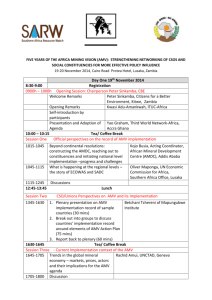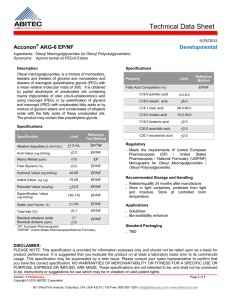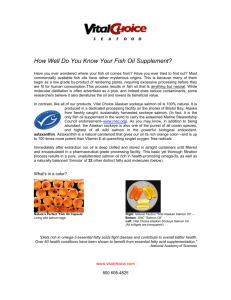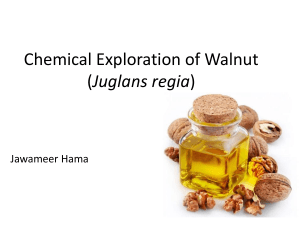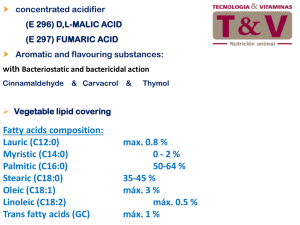감마선 조사가 건조-발효소시지의 Trans 지방산, 유리아미노산 및 관능검사 특성에 미치는 영향
advertisement
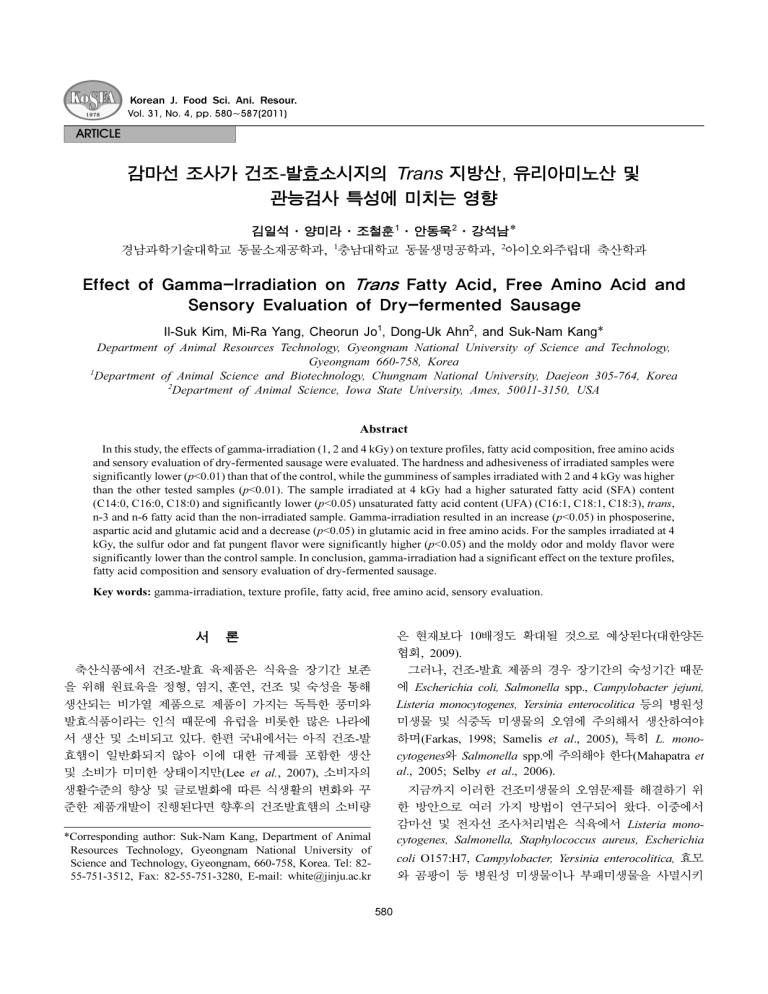
Korean J. Food Sci. Ani. Resour. Vol. 31, No. 4, pp. 580~587(2011) ARTICLE 감마선 조사가 건조-발효소시지의 Trans 지방산, 유리아미노산 및 관능검사 특성에 미치는 영향 김일석·양미라·조철훈1·안동욱2·강석남* 경남과학기술대학교 동물소재공학과, 1충남대학교 동물생명공학과, 2아이오와주립대 축산학과 Effect of Gamma-Irradiation on Trans Fatty Acid, Free Amino Acid and Sensory Evaluation of Dry-fermented Sausage Il-Suk Kim, Mi-Ra Yang, Cheorun Jo1, Dong-Uk Ahn2, and Suk-Nam Kang* Department of Animal Resources Technology, Gyeongnam National University of Science and Technology, Gyeongnam 660-758, Korea 1 Department of Animal Science and Biotechnology, Chungnam National University, Daejeon 305-764, Korea 2 Department of Animal Science, Iowa State University, Ames, 50011-3150, USA Abstract In this study, the effects of gamma-irradiation (1, 2 and 4 kGy) on texture profiles, fatty acid composition, free amino acids and sensory evaluation of dry-fermented sausage were evaluated. The hardness and adhesiveness of irradiated samples were significantly lower (p<0.01) than that of the control, while the gumminess of samples irradiated with 2 and 4 kGy was higher than the other tested samples (p<0.01). The sample irradiated at 4 kGy had a higher saturated fatty acid (SFA) content (C14:0, C16:0, C18:0) and significantly lower (p<0.05) unsaturated fatty acid content (UFA) (C16:1, C18:1, C18:3), trans, n-3 and n-6 fatty acid than the non-irradiated sample. Gamma-irradiation resulted in an increase (p<0.05) in phosposerine, aspartic acid and glutamic acid and a decrease (p<0.05) in glutamic acid in free amino acids. For the samples irradiated at 4 kGy, the sulfur odor and fat pungent flavor were significantly higher (p<0.05) and the moldy odor and moldy flavor were significantly lower than the control sample. In conclusion, gamma-irradiation had a significant effect on the texture profiles, fatty acid composition and sensory evaluation of dry-fermented sausage. Key words: gamma-irradiation, texture profile, fatty acid, free amino acid, sensory evaluation. 서 론 은 현재보다 10배정도 확대될 것으로 예상된다(대한양돈 협회, 2009). 그러나, 건조-발효 제품의 경우 장기간의 숙성기간 때문 에 Escherichia coli, Salmonella spp., Campylobacter jejuni, Listeria monocytogenes, Yersinia enterocolitica 등의 병원성 축산식품에서 건조-발효 육제품은 식육을 장기간 보존 을 위해 원료육을 정형, 염지, 훈연, 건조 및 숙성을 통해 생산되는 비가열 제품으로 제품이 가지는 독특한 풍미와 발효식품이라는 인식 때문에 유럽을 비롯한 많은 나라에 서 생산 및 소비되고 있다. 한편 국내에서는 아직 건조-발 효햄이 일반화되지 않아 이에 대한 규제를 포함한 생산 및 소비가 미미한 상태이지만(Lee et al., 2007), 소비자의 생활수준의 향상 및 글로벌화에 따른 식생활의 변화와 꾸 준한 제품개발이 진행된다면 향후의 건조발효햄의 소비량 미생물 및 식중독 미생물의 오염에 주의해서 생산하여야 하며(Farkas, 1998; Samelis et al., 2005), 특히 L. monocytogenes와 Salmonella spp.에 주의해야 한다(Mahapatra et al., 2005; Selby et al., 2006). 지금까지 이러한 건조미생물의 오염문제를 해결하기 위 한 방안으로 여러 가지 방법이 연구되어 왔다. 이중에서 감마선 및 전자선 조사처리법은 식육에서 Listeria monocytogenes, Salmonella, Staphylococcus aureus, Escherichia *Corresponding author: Suk-Nam Kang, Department of Animal Resources Technology, Gyeongnam National University of Science and Technology, Gyeongnam, 660-758, Korea. Tel: 8255-751-3512, Fax: 82-55-751-3280, E-mail: white@jinju.ac.kr coli O157:H7, Campylobacter, Yersinia enterocolitica, 효모 와 곰팡이 등 병원성 미생물이나 부패미생물을 사멸시키 580 Effect of Gamma Irradiation on Dry-fermented Sausage 거나 줄이는데 효과적이기 때문에 공중위생차원에서 식육 의 위생개념에서 그 사용이 증가되고 있다. 하지만, 이러한 조사 처리가 지방의 산화를 촉진시키고 불쾌취를 생성하기 때문에 이를 최소화 하는 방향으로 연 구가 진행 중에 있다(Brewer, 2009; Sohn et al., 2009). 이 중에서 지방산의 변화는 닭고기(Rady et al., 1987), 쇠고 기(Brito et al., 2002; Chen et al., 2007; Stefanova et al., 2011; Yilmaz and Gecgel, 2007), 양고기(Alfaia et al., 2007) 등의 식육 위주로 이루어 졌고, 가열 가공육의 경 우 일부(Jo and Ahn, 2000)가 연구되어져 왔으나, 아직까 지 건조-발효소시지에 대한 연구는 거의 없는 실정이다. 이에 본 연구는 감마선 처리에 의한 건조-발효 소시지의 지방산, 유리아미노산 및 관능적 특성 변화를 알아보기 위 해 실시하였다. 재료 및 방법 시료 준비 건조-발효 소시지는 돈육 등심과 등지방을 5 mm의 크 기로 세절(Model 5K5SS, USA)한 이후 lactic acid bacteria 위주의 상업적인 starter culture를 접종하였다. 양념 및 첨 가제는 모두 엠에스씨(MSC Co., Ltd., Seongnam, Korea) 에서 소시지제조용으로 구입하여 사용하였으며, 모든 소 시지는 동일한날 동일 배치에서 혼합한 이후 제조하였으 며, 혼합물은 적육(86%), 등지방(9%), 소금(2.5%), NaNO3 (0.012%), NaNO2(0.008%), sodium ascorbate(0.25%), 글루 코스(0.3%), 당(0.4%), 후추(0.4%), 마늘(0.5%) 그리고 스 파이스(0.58%)을 혼합하여 제조하였다. 제조에 이용된 starter는 Lactobacillus pentosus와 Staphylococcus carnosus (C-P-77S BactofermTM, Chr. Hansen Inc., Germany)는 균 수가 9 Log CFU/g 이상으로 적육 무게의 0.05%를 사용하 여 제조공정 매뉴얼에 따라 제조하였다. 소시지는 45 mm 직경의 합성케이싱에 200 g(±1.0 g)씩 넣어 숙성실에서 숙 성시켰다. 이때의 온도와 상대습도는 각각 10oC 및 70% 였으며, 30일간 건조숙성이 지난 이후 진공포장(0.5 cm3/ m2/atm/24 h, Danisco Flexible Lyngby, Denmark)하여 4oC 에서 3일간 보관한 시료를 이용하였다. 시료의 제조는 동 일한 방식으로 2회 제조하여 실험에 이용하였다. 시료의 분석은 감마선조사후 7일 이후에 실시하였다. 감마선 조사 시료의 감마선 조사는 선원 11.1 PBq, Co-60 감마선 조 사시설(IR-79 gamma irradiator, MDS Nordion, Canada)을 이용하여 실온(20±1oC)에서 흡수량이 1.0, 2.0 및 4.0 kGy 가 되도록 조사하였으며 흡수선량의 확인은 방사선 선량 계(ceric cerous dosimeter, Bruker Instruments, Germany)를 사용하였다. 선량계는 국제원자력기구(IAEA)의 규격에 준 581 용하여 표준화한 후 사용하였으며, 총 흡수선량의 오차는 2% 이내였다. 조직감 측정 건조-발효 소시지의 조직감(texture profile)는 Instron 3343(US/MX50, A&D Co., USA)을 이용하여 직경을 45 mm, 높이가 20 mm인 원통으로 잘라 plunger No. 3으로 세로방향으로 압력을 가하여 측정하였다. 조직감 분석은 Texture Technologies(2003)의 방법에 준하여 계산하였다. 조직감의 분석항목은 경도(hardness), 파쇄성(brittleness), 응 집성(cohesiveness), 검성(gumminess), 씹힘성(chewiness), 탄력성(springiness), 부착성(adhesiveness)에 대해서 조사하 였다. 이때 측정 조건은 load cell 10 kg, adapter area 28 mm2 이었다. 지방산 지방산 분석은 Folch 등(1957)의 방법에 따라 추출된 지 방으로 분석에 이용하였다. 20 mg의 지질을 플라스크에 넣 고 reflux관에 장착한 이후 10 mL 2 mM NaOH in methanol 을 첨가하여 10분간 가열하여 비누화 과정을 거쳤으며, 이 후 4% H2SO4 in methanol을 3 mL 가한 후 20분 동안 가 열하면서 5분마다 vortexing을 실시하여 methylation을 시 켰다. 방냉 이후 1 mL hexane을 가하여 지방산을 추출하고 이를 FID(flame ionization detector)가 장착된 GC(Agilent 6890, Agilent Technologies Inc., Palo Alto, CA, USA)로 분석하였다. 분석조건은 column은 SP-2560(100 m×0.25 mm I.D., 0.20 µm)를 이용하여 측정하였으며, 오븐온도는 80oC에서 단계 승온하여 200oC까지 측정하였으며, injection 및 detector온도는 250oC 였으며, 이동상은 helium으로 20 cm/s로 흘려주었으며, split ratio는 100:1로 1 µL 시료를 주 입하여 분석하였다. 지방산 정량은 FAME(fatty acid methyl ester) standard 물질을 이용하여 동일 retention time을 확 인하여 분석하였다. Σn-3 PUFA는 linolenic acid(C18:3n3), eicosapentaenoic acid(C20:5n3), docosapantaenoic acid (C22:5n3), docosahexaenoic acid(C22:6n3)의 합으로 계산 하였으며, Σn-6 PUFA는 linoleic acid(C18:2n6), γ-linolenic acid(C18:3n6), eicosadienoic acid(C20:2n6), eicosatrienoic acid(C20:3n6), arachidonic acid(C20:4n6), docosatetraenoic acid(C22:4n6)의 합으로 계산하였다. 동맥경화지수(Atherogenicity index, AI)와 혈전형성지수(Thrombogenicity Index, TI)는 Ulbricht와 Southgate(1991)의 방법에 의해 다음과 같 이 계산하였다. AI = (4×C14:0+C16:0)/(MUFA+PUFA) TI = (C16:0+C18:0)/(0.5×(MUFA+Σn-6 PUFA) + 3 × (Σn-3 PUFA) + (Σn-3 PUFA/Σn-6 PUFA)) 582 Korean J. Food Sci. Ani. Resour., Vol. 31, No. 4 (2011) 유리아미노산 유리아미노산 분석을 위한 시료 전처리는 Aristoy와 Toldrá (1991)의 방법으로 수행하였으며, 최종 유리아미노산 함량 분석은 Hypersil ODS, 200×2.1 mm, 5 µm 칼럼(Agilent Technologies, USA)을 이용하여 HPLC(Agilent 1100, Agilent Technologies)로 분석하였다. 이동상 A는 40 mM Na2HPO4 (pH 7.8), B는 acetonitrile:methanol:distilled water=45:45: 10 (v/v/v)을 제조하여 사용하였다. 외부 표준물질은 Agilent Technologies사에서 생산되는 amino acid standard(0.25 mM/µL)와 glutamine(Sigma-aldrich, USA)을 사용하였고, OPA(orthophthalaldehyde) reagent, FMOC(fluorenylmethoxy carbonyl chloride) reagent(Agilent technologies)를 각각 유도 체로 사용하였다. 관능검사 관능검사는 감마선 조사 건조-발효소시지 대해서 황취 (sulfur odor), 곰팡이 냄새(moldy odor), 조직감(texture), 금 속 맛(metallic flavor), 산화 맛(fat pungent flavor), 곰팡이 맛(moldy flavor), 단맛(sweetness)은 Civille와 Lyon(1996) 과 Pham 등(2008)의 방법에 준하여 예비 실험을 실시하 였다. 건조-발효소시지에 대에 훈련된 12명의 관능검사 요 원을 선발하여 9점 척도법으로 관능검사를 실시하였다. 모 든 시료는 1.5 mm로 슬라이스하여 난수표를 이용하여 번 호를 구분한 이후 밀패 용기에 담아 관능검사요원에게 제 공하였다. 이때 평가점수는 황취, 곰팡이 냄새, 금속 맛, 산화 맛 그리고 곰팡이 맛은 1-3: 약함, 4-6: 보통, 7-9: 강 함으로 평가하였고, 조직감 및 단맛은 1-3: 매우 좋지 않 음, 4-6: 보통, 7-9: 매우 좋음으로 구분하여 평가하였다. 통계 분석 SAS program(Statistics Analytical System, USA, 1999) 의 GLM(General Linear Model) 방법으로 분석하였다. 처 리 평균 간의 평균값 비교를 위해 Duncan의 다변위 검정 (Duncan’s multiple range test)을 통하여 5% 수준에서 각 시료간의 유의적인 차이를 검정하였다. 결과 및 고찰 조직감 방사선 조사가 근절내부의 단백질 공유결합이 약화와 titin과 nebulin 등의 단백질의 붕괴를 가져오며(Horowits et al., 1986), 결체조직과 근섬유가 분해되어 경도가 낮아 지며(Park et al., 2004), 근육 내 효소활성을 증가시켜 당 대사를 가속화한다고(Bowes and Moss, 1962) 보고되었다. Table 1은 감마선 조사가 건조-발효햄의 조직감(TPA) 특 성을 나타낸 표이다. 경도(hardness) 및 부착성(adhesiveness) 의 경우 조사 처리구가 유의적으로 낮게 나타났다(p<0.01). 또한, 검성(gumminess)은 2 및 4 kGy처리구가 대조구 및 1 kGy처리구보다 유의적으로 높은 값을 나타내었다(p<0.01). 이러한 결과는 Ahn 등(2002)의 조사처리가 단백질 아미노 산의 side chain의 붕괴에 영향을 미친다는 보고와 Byun 등(2001)의 조사처리가 연도가 증가한다고 보고한 결과와 유사하였다. 이러한 결과는 조사처리가 조직감 중 연도 에 영향을 미치는 것으로 사료된다. 본 연구에서 응집성(cohesiveness), 탄력성(springness) 그리고 씹힘성(chewiness)은 감마선 조사에 따른 유의적인 차이가 나타나지 않았다. Galán 등(2011)은 냉장상태 보관된 진공포장된 소시지에 2-4 kGy 전자선 조사시, Cabeza 등(2007)는 가열햄을 4 kGy까지 전자선조사 시에 그리고 Lee와 Ahn(2005)는 진 공포장된 가열 칠면조 가슴육의 조직감에 3 kGy 전자선 조사 시 영향이 없었다고 하였다. 하지만, Yoon (2003)은 신선 닭가슴육에 2.9 kGy 감마선 조사 시 sarcomeres의 myofibrils과 2차 근섬유의 수축으로 경도가 증가하였다고 보고하여 본 연구와 차이를 나타내었다. 지방산 Table 2는 감마선 조사육의 지방산 변화를 나타낸 표이 다. 건조-발효소시지의 주요 지방산비율은 myristic acid (C14:0), palmitic acid(C16:0), stearic acid(C18:0)이 각각 1.87, 17.47, 8.71%이었으며, palmitoleic acid(C16:1), stearic acid(C18:1), linoleic acid(C18:2), linolenic acid(C18:3), cis-5,8,11,14,17-eicosapentaenoic acid(C20:5)가 각각 2.84, 40.03, 18.46, 2.18, 3.69으로 나타나, C16:0, C18:1, C18:2 가 주요 지방산으로 나타났다. 감마선 조사시 C14:0, C16:0, Table 1. Effect of gamma radiation on texture profiles of dry-fermented sausage Doses (kGy) Hardness (kg) Cohesiveness (ratio) Springness (ratio) Gumminess (kg) Chewiness (kg) Adhesiveness (kg) a-b 0 0.85±0.08 0.52±0.05 1.02±0.03 0.61±0.05 0.42±0.04 0.21±0.03 1 a a a 0.67±0.07 0.90±0.24 1.81±0.31 0.72±0.16 1.19±0.70 0.15±0.01 2 b a b Comparison within a row without common superscript are significantly different (p<0.01). 0.55±0.09 0.78±0.37 1.57±0.75 0.34±0.12 1.03±0.61 0.12±0.01 4 b b b 0.62±0.04 0.58±0.07 1.09±0.09 0.35±0.04 0.38±0.08 0.12±0.01 b b b 583 Effect of Gamma Irradiation on Dry-fermented Sausage Table 2. Effect of gamma radiation on fatty acid composition and partial sums of fatty acids (%, w/w) of dry-fermented sausage Doses (kGy) 0 1 b Myristic C14:0 Myristoleic C14:1 Palmitic C16:0 C16:1t9 C16:1w9 1.87±0.06 ND 17.47±0.05 0.15±0.02 0.48±0.03 ΣC16:1 2.84±0.03 Palmitoleic C16:1n7 C16:2n4 C16:4n1 2.21±0.03 0.79±0.03 0.93±0.04 Stearic C18:0 8.71±0.05 1.68±0.08 34.12±0.38 3.87±0.17 0.37±0.04 Elaidic C18:1n9t Oleic C18:1n9c C18:1cis11 C18:1cis12 1) b a a 2 a 2.18±0.13 ND 17.73±0.09 0.18±0.02 0.41±0.03 a b 4 a a 1.98±0.06 ND 17.85±0.08 0.02±0.01 0.36±0.02 b c a a 2.06±0.08 ND 17.61±0.06 0.03±0.01 0.17±0.04 a b d a 2.79±0.04 b 2.65±0.04 c 7.73±0.04 c 2.20±0.02 0.90±0.04 0.97±0.04 c 2.28±0.03 0.88±0.03 0.86±0.02 b 2.53±0.07 0.86±0.02 0.82±0.04 d 9.10±0.06 a 8.98±0.04 b 8.83±0.05 a 1.64±0.09 32.59±0.18 4.26±0.14 0.39±0.03 a 1.24±0.08 32.80±24 4.99±0.12 0.37±0.04 c 1.46±0.07 32.95±0.17 5.18±0.13a 0.28±0.04 a 38.88±0.12 b 39.39±0.10 b 39.86±0.08 0.17±0.03 0.07±0.01 ND 18.13±0.14 ND b 0.06±0.03 0.01±0.01 ND 18.74±0.12 ND c ND 0.01±0.01 ND 18.69±0.15 ND b ab a c a a a b b a a c b b a a c c b b a a b ΣC18:1 40.03±0.11 C18:2 t9t12 C18:2 c9t12 C18:2 t9c12 Linoleic C18:2n6c Linolelaidic C18:2n6t 0.23±0.02 0.08±0.01 ND 18.14±0.11 ND a ΣC18:2 18.46±0.10 b 18.37±0.12 b 18.81±0.12 a 18.70±0.09 a 0.95±0.03 1.11±0.04 b 0.87±0.04 1.22±0.03 c 0.86±0.05 1.23±0.02 b 2.09±0.03 b a b γ-linolenic C18:3n6 α-Linolenic C18:3n3 1.07±0.03 1.10±0.02 ΣC18:3 2.18±0.03 2.06±0.03 Arachidic C20:0 Eicosenoic C20:1n9 Eicosadienoic C20:2n6 Eicosatrinoic C20:3n3 Arachidonic C20:4n6 Eicosapentaenoic C20:5n3 Behenic C22:0 Docosapantaenoic C22:5n3 Docosahexaenoic C22:6n3 ND 0.78±0.02 0.33±0.03 0.58±0.06 3.69±0.08 0.14±0.03 0.36±0.04 0.39±0.02 0.44±0.04 ND 0.79±0.02 0.27±0.03 0.60±0.04 4.06±0.04 0.16±0.02 0.26±0.04 0.43±0.02 0.47±0.04 ΣSFA ΣMUFA ΣUFA ΣPUFA ΣPUFA/ΣSFA ΣMUFA/ΣSFA Σn-3 PUFA Σn-6 PUFA Σn-6 PUFA/Σn-3 PUFA Total trans AI TI 2) 3) b a a c a c 28.42 43.66 71.95 27.93 0.98 0.61 2.26 22.90 10.13 2.14 0.35 0.22 a b b a a b b ab a b a 29.26 42.46 71.00 28.28 0.97 0.60 2.33 23.14 9.92 2.06 0.37 0.23 c b a b ND 0.78±0.01 0.22±0.02 0.49±0.08 3.90±0.06 0.12±0.04 0.18±0.03 0.40±0.02 0.43±0.05 28.99 42.82 71.19 28.19 0.97 0.60 2.26 23.50 10.41 1.33 0.36 0.23 a c b a c b a a b b c b d b ab a c a b 2.09±0.04 ND 0.80±0.01 0.16±0.03 0.59±0.07 3.84±0.06 0.14±0.02 0.09±0.04 0.40±0.02 0.43±0.02 28.59 43.39 71.50 28.02 0.98 0.61 2.39 23.38 9.80 1.50 0.36 0.22 c b d b b a a c The symbols mean as follow: SFA, saturated fatty acids; UFA, unsaturated fatty acids; MUFA, monounsaturated fatty acids; PUFA, polyunsaturated fatty acid. Σn-3 PUFA = ΣC18:3n3, C20:5n3, C22:5n3 and C22:6n3 Σn-6 PUFA = ΣC18:2n6, C18:3n6, C20:2n6, C20:3n6, C20:4n6 and C22:4n6 Comparisons within a row without common superscript are significantly different (p<0.05). ND means not detected. AI=(4×C14:0+C16:0)/(MUFA+PUFA) 3 TI=(C16:0+C18:0)/(0.5×(MUFA+Σn-6 PUFA)+3×(Σn-3 PUFA)+(Σn-3 PUFA/Σn-6 PUFA)) a-d 1 2 584 Korean J. Food Sci. Ani. Resour., Vol. 31, No. 4 (2011) C18:0은 유의적으로 증가(p<0.05)하였으며 C22:0은 감소 (p<0.05)하여 총 포화지방산(SFA)는 증가하는 경향이었다 (p<0.05). C16:1, C18:1 및 C18:3은 조사처리구가 대조구 보다 낮게 나타났으며(p<0.05), C18:2는 4 kGy 처리구가 대조구보다 높게 나타났다(p<0.05). 총 불포화지방산(UFA) 은 조사처리가 대조구보다 낮게 나타났지만 유의적인 차 이는 없었다. 이상의 결과는 Stefanova 등(2011)의 해동 쇠 고기에 2.5에서 15 kGy까지 감마선을 조사처리 시 포화 지방산(C16:0과 C18:0) 함량이 증가하고, 불포화지방산 (C18:2와 C18:3)이 감소하였다는 보고와 유사하였다. 이러 한 결과는 조사처리가 불포화지방산의 지방산 조성에 영 향을 미치는 것으로 사료된다. 일반적으로 지방이 함유된 식품은 조사처리에 민감하 며, 높은 에너지의 조사처리가 지방의 산화를 직접적으로 유발한다고 알려져 있다. Nawar(1986)은 조사처리가 불포 화지방산의 triacylglycerol 내 acyl group의 활성 free radical의 형성을 통해 자동산화를 가속화시켜 지방의 산 화를 촉진시키기 때문에 불포화지방산의 감소의 감소를 가져온다고 하였다. Trans 지방은 인간이 소비하는 동물성 지질(낙농제품 및 쇠고기 지방) 내에 2-4.5%가 존재하며, 지방의 double bond 가 붕괴되면서 free radical과 trans 지방산으로 분리되면 서 생성하게 되며, trans 지방산의 함량은 사료나 반추위 활동에 의해 변화하며 식육의 저장에 따라서도 그 함량이 변화한다(Yilmaz and Gecgel, 2007). 건조-발효 소지지의 trans 지방의 함량은 2.14%로 Yilmaz와 Gecgel(2007)의 분쇄 쇠고기 6.96% 보다 낮게 나타났으며, 2 kGy처리구 에서는 오히려 trans 지방산이 1.50%로 낮아졌다(p<0.05). 본 연구에서 trans 지방산의 경우 C18:1n9t, C18:2t9t12, C18:2c9t12가 감마선 처리구에서 유의적으로 감소한 반면, C18:2n6c는 증가하는 경향이었다. 이에 따라 총 감마선 처 리구의 trans 지방산이 유의적으로 감소하였다(p<0.05). 하 지만 C18:2t9c12와 C18:2n6t는 모든 시험구에서 검출되지 않았다. 이러한 결과는 Yilmaz와 Gecegl(2007)은 분쇄 쇠 고기에서 감마선 조사가 증가할수록 총 trans 지방산의 함 량이 증가하였다고 보고한 결과와 차이를 나타내었다. Trans 지방산은 다양한 식품에 존재하며, 포화지방산과 유사하게 trans 지방산의 급여는 low density-lipoprotein(LDL) 콜레스테롤함량을 증가시키고 high density-lipoprotein(HDL) 콜레스테롤함량을 줄이기 때문에 관상 동맥 심장질환(CHD, coronary heart disease)의 위험성(Fritsche et al., 1988; Ulbricht and Southgate, 1991) 및 심장병의 발병을 증가시 키며(Willet and Ascherio, 1994), 그 위험성은 포화지방산 의 4배 위험성이 있다고 알려져 있다(Fritsche and Steinhart, 1997; Litin and Sacks, 1993; Menssink and Katan, 1990). 따라서 식품의 가공처리시 trans함량의 증가가 되지 않도록 유의하여야 하며 미 FDA(Food and Agriculture Organiza- tion)과 세계보건기구(WHO, World Health Organization)은 식품에 존재하는 trans 지방이 전체지방의 4% 이하로 줄 여야 한다고 권고하였다(WHO, 2003). 본 연구의 돈육을 이용한 건조-발효 소시지의 동맥경화지수(AI) 및 혈전형성 지수(TI)는 각각 0.35-0.36 및 0.22-0.23으로 매우 낮게 나 타났으며, 시료간에는 유의적인 차이가 나타나지 않았다 (p>0.05). 주요 trans 지방산은 C18:1에서 기인한다고 알려 져 있으며 본 연구의 건조-발효소시지 trans 지방산은 C18:2t9t12>C16:1t9>C18:2c9t12 순으로 C18:2t9t12가 주요 trans 지방산으로 나타났다. n-3 및 n-6 지방산은 4 kGy처리구가 다른 시험구보다 유의적으로 높게 나타났다(p<0.05). 유럽의 경우 n-6/n-3의 비율이 4.0이상이 되지 않도록 권고하고 있지만(UK Department of Health, 1994), 본 실험의 n-6/n-3의 비율은 10.41-9.80으로 시험구간 유의적인 차이는 나타나지 않았 으나 유럽의 권고수준에 비해 높은 수준으로 나타났다. PUFA/SFA의 함량은 CHD와 연관이 있으며(Muguerza et al., 2001), 모든 시험구에서 0.98-0.99수준으로 유의적인 차이는 없었으며 식품 권고수준 내의 수치로 나타났다. 유리아미노산 건조-발효 육제품의 독특한 향과 풍미는 장기 숙성기간 동안 내부에서 일어나는 효소적 작용들과 화학반응들에 의해 생성되는 것이며, 품질을 결정하는 주요한 요소로 작 용한다(Toldra et al., 1992; Ventanas et al., 1992). Careri 등(1993)은 lysine과 tyrosine은 파마햄의 독특한 숙성된 맛 을 증가시키데 연관이 있으며, glutamic acid는 짠맛과 연 관이 있으며, phenylalanine과 isoleucine은 신맛에 긍정적 인 기여를 하며, tyrosine은 부정적인 기여를 한다고 보고 하였다. Mau와 Tseng(1998)은 발효햄의 숙성과정 중 ornithine, isoleucine, tryptophan, methionine, tyrosine, threonine, glycine의 증가가 쓴맛의 주요물질이라고 보고 하였다. Table 3은 감마선 조사 건조-발효소시지의 유리아 미노산 함량(mg%)을 나타낸 표이다. 건조-발효소시지의 유리아미노산의 함량은 alanine, leucine, glutamic acid, taurine, valine, phenylalanine가 각각 105.11, 76.27, 68.12, 59.83, 51.49 mg%, 48.19 mg%으로 alanine이 가장 높은 함량을 나타내었다. 총 유리아미노산 함량은 감마선 처리 구(722.27-803.95 mg%)가 대조구(661.96 mg%)보다 높게 나타났으나 유의성은 없었다. phosposerine, aspartic acid, glutamic acid은 감마선 조사처리로 유의적으로 증가하였 으나(p<0.05), lysine은 유의적으로 감소하였다(p<0.05). Glutamic acid는 효소의 deamidation에 의해 생성(Dura et al., 2004) 되는 것으로 추정되며, 맛에 가장 큰 영향을 미 치며, 다른 정미성분과 공존할 시에는 맛의 상승 작용을 나타내기도 한다. 585 Effect of Gamma Irradiation on Dry-fermented Sausage Table 3. Effect of gamma radiation on free amino acid (mg%) of dry-fermented sausage Doses (kGy) Phosposerine Taurine Aspartic acid Threonine Serine Glutamic acid Proline Glysine Alanine Citrulline Valine Methione Isoleucine Leucine Tyrosine Phenylalanine Lysine Histidine Arginine Total a-c 0 1 b 2 ab 5.19±0.43 56.44±4.23 3.79±0.35 22.41±1.86 25.31±3.56 82.00±5.86 28.17±2.86 35.03±3.45 116.80±11.32 2.48±0.45 56.50±3.56 33.15±2.56 41.84±3.12 80.41±5.23 23.51±1.56 51.93±3.76 21.38±2.32 33.40±2.45 2.53±0.26 722.27±51.23 4.51±0.42 59.83±5.32 2.55±0.32 19.75±2.12 22.31±2.86 68.12±6.56 24.03±3.45 30.55±3.25 105.11±10.25 2.60±0.56 51.49±3.43 32.46±2.56 39.87±3.42 76.27±4.56 21.65±1.56 48.19±3.56 19.96±2.49 30.21±2.56 2.50±0.23 661.96±52.12 b 5.41±0.27 56.30±4.42 3.97±0.43 23.72±1.45 27.80±3.15 97.07±6.42 22.84±3.31 37.78±3.78 120.77±12.52 2.50±0.62 57.03±3.97 32.04±2.75 41.87±3.56 79.13±3.68 23.19±2.39 52.64±4.19 15.12±1.65 34.50±2.17 2.48±0.24 736.16±49.56 a b a a 5.38±0.45 64.84±4.56 3.71±0.51 24.17±1.25 30.55±3.76 99.04±6.62 26.18±2.75 40.20±3.65 129.31±13.56 2.83±0.25 59.76±3.45 38.15±2.85 45.42±3.25 85.63±5.27 25.19±2.12 58.55±3.98 24.88±2.64 37.69±2.42 2.48±0.21 803.95±48.52 a c 4 ab a a a a a b Comparisons within a row without common superscript are significantly different (p<0.05). Table 4. Effect of gamma radiation on sensory evaluation of dry-fermented sausage Dose (kGy) Sulfur odor Moldy odor Texture Metallic flavor Fat pungent flavor Moldy flavor Sweetness a-c 0 2.60±0.17 2.70±0.44 3.50±0.36 3.63±0.35 2.30±0.20 3.30±0.26 3.47±0.06 1 b a b a a 2.17±0.15 1.77±1.16 3.30±0.30 3.37±0.32 2.10±0.26 2.67±0.49 3.30±0.36 2 c a b ab a 4 2.17±0.15 1.10±0.17 3.33±0.32 3.63±0.31 2.17±0.15 2.37±0.47 2.37±0.32 c a 3.13±0.06 1.23±0.21 3.47±0.35 3.53±0.25 2.53±0.15 1.77±0.49 2.33±0.49 b b b a b c b b Comparison within a row without common superscript are significantly different (p<0.05). 관능검사 Table 4는 감마선 조사 건조-발효소시지의 관능적 특성 을 나타낸 표이다. 분석결과 황취(sulfur odor) 및 지방산 화 맛(fat pungent flavor)은 4 kGy에서 가장 높게 나타났 다(p<0.05). Ahn 등(2002)의 조사처리가 단백질 아미노산 의 side chain의 붕괴시켜 불쾌취를 발산한다고 보고한 것 과 유사하게 본 연구에서의 감마선 조사시 발생하는 황취 및 지방산화 맛이 불쾌취에 영향을 미쳤다. 또한, 곰팡이 냄새(moldy odor) 및 곰팡이 맛(moldy flavor)은 대조구보 다 4 kGy처리에서 유의적으로 낮게 나타났다(p<0.05). 이 러한 결과는 조사처리 시 병원성 및 식중독 미생물의 감 소 및 사멸(Chung et al., 2007)로 인한 미생물 냄새의 감 소하기 때문으로 사료된다. 조직감(texture) 및 금속 맛 (metallic flavor)에서는 시험구간 비교에서 유의적인 차이 가 나타나지 않았으나, 단맛은 2 kGy 이상 처리구가 낮게 나타났다(p<0.05). 감마선 조사 시 곰팡이 냄새 및 곰팡이 맛의 저하에 영향을 미치며, 단맛의 저하에 영향을 미치 는 것으로 나타났다. 지방산 조성은 고기의 맛과 풍미 그 리고 인간의 건강에 영향을 준다(UK Development of Health, 1994). 단일불포화지방산(MUFA)에 대한 SFA의 비 율(MUFA/SFA)은 식육의 맛을 결정짓는 간접적인 지표가 될 수 있다고 보고하였다(Anderson et al., 1975). 본 연구 에서 MUFA/SFA의 비율은 0.60-0.61 수준으로 유의적인 차이가 나타나지 않았으며, 관능검사의 단맛과는 상관도 가 없었다. 요 약 본 연구는 감마선 조사가 건조-발효햄의 조직감, 지방산, 유리아미노산 및 관능적 특성에 미치는 영향을 조사하기 위해 실시하였다. 경도(hardness) 및 부착성(adhesiveness) 의 경우 조사 처리구가 유의적으로 낮게 나타났다(p<0.01). 586 Korean J. Food Sci. Ani. Resour., Vol. 31, No. 4 (2011) 검성(gumminess)의 경우에는 2 및 4 kGy처리구가 대조구 및 1 kGy처리구보다 유의적으로 높은 값을 나타내었다 (p<0.01). 지방산의 경우 처리구의 포화지방산(SFA)(C14:0, C16:0, C18:0)은 유의적으로 높았고(p<0.05), 불포화지방산 (UFA)(C16:1, C18:1 및 C18:3), trans 지방산, n-3 및 n-6 지방산 의 함량은 4 kGy처리에서 감소하였다(p<0.05). 감 마선 조사처리는 phosposerine, aspartic acid, glutamic acid 를 증가 시켰으나, lysine은 감소시켰다(p<0.05). 관능검사 의 경우, 황취(sulfur odor) 및 지방산화 맛(fat pungent flavor)은 4 kGy에서 가장 높게 나타났으며(p<0.05), 곰팡 이 냄새(moldy odor) 및 곰팡이 맛(moldy flavor)은 낮게 나타났다(p<0.05). 이상의 결과 감마선 조사가 조직감, 지 방산조성 및 관능적 특성에 영향을 미쳤다. 감사의 글 본 연구는 경남과학기술대학교의 기성회연구비와 중점 연구소 지원으로 이루어 졌으며 이에 감사드립니다. 참고문헌 1. Ahn, D. U. (2002) Production of volatiles from amino acid homopolymers by irradiation. Food Sci. 67, 2565-2570. 2. Alfaia, C. M. M., Ribeiro, P. J. L. C., Trigo, M. J. P., Alfaia, A. J. I., Castro, M. L. F., Fontes, C. M. G. A., Bessa, R. J. B., and Prates, J. A. M. (2007) Irradiation effect on fatty acid composition and conjugated linoleic acid isomers in frozen lamb meat. Meat Sci. 77, 689-695. 3. Anderson, D. A. Kisellan, J. A., and Watt, B. K. (1975) Comprehensive evaluation of fatty acid in beefs. J. Anim. Diet Assoc. 67, 35-43. 4. Aristoy, M. C. and Toldrá, F. (1991) Deproteinization techniques for HPLC amino acid analysis in fresh muscle and dry-cured ham. J. Agric. Food Chem. 39, 1792-1795. 5. Bowes, J. H. and Moss, J. A. (1962) The effect of gamma radiation on collagen. Radiat. Res. 16, 211-223. 6. Brewer, M. S. (2009) Irradiation effects on meat flavor: A review. Meat Sci. 81, 1-14. 7. Brito, M. S., Villavicencio, A. L. C. H., and Mancini-Wlho, J. (2002) Effects of irradiation on trans fatty acids formation in ground beef. Radio. Phys. Chem. 63, 337-340. 8. Byun, M., Lee, J. W., Jo, C., and Yook, H. S. (2001) Quality properties of sausage made with gamma-irradiated natural pork and lamb casing. Meat Sci. 59, 223-228. 9. Cabeza, M. C., Cambero, I., de la Hoz, L., and Ordóñez, J. A. (2007) Optimization of E-beam irradiation treatment to eliminate Listeria monocytogenes from ready-to-eat (RTE) cooked ham. Inno. Food Sci. Emerg. Technol. 8, 299-305. 10. Cameron, N. D. and Enser, M. B. (1991) Fatty acid composition of lipid in longissimus dorsi muscle of Duroc and British Landrace pigs and its relationship with eating quality. Meat Sci. 29, 295-307. 11. Careri, M., Mangia, A., Barbieri, G., Bolzoni, L., Virgili, R., and Parolari, G. (1993) Sensory property relationship to chemical data of Italian type dry-cured ham. J. Food Sci. 58, 968-972. 12. Chen, Y. J., Zhou G. H., Zhu, X. D., Xu, X. L., Tang, X. Y., and Gao, F. (2007) Effect of low dose gamma irradiation on beef quality and fatty acid composition of beef intramuscular lipid. Meat Sci. 75, 423-431. 13. Chung, H. J., Lee, N. Y., Jo, C., Shin, D. H., and Byun, M. W. (2007) Use of gamma irradiation for inactivation of pathogens inoculated into Kimbab, steamed rice rolled by dried laver. Food Control 18, 108-112. 14. Civille, G. V. and Lyon, B. G. (1998) Aroma and flavor lexicon for sensory evaluation: Terms, definitions, references, and examples. Pennylvania: ASTM Data Series Publication DS 66, ASTM. 15. Development of Health (1994) Nutrional aspects of the cardiovascular disease. Report of health and social subjects No. 46. London : Her Majesty's Stationery Office. 16. Dura, M. A., Flores, M., and Toldra, F. (2004) Effects of curing agents and the stability of a glutaminase from Debaryomyces spp. Food Chem. 86, 385-389. 17. Farkas, J. (1998) Irradiation as a method for decontaminating food. A review. Int. J. Food Microbiol. 44, 189-204. 18. Folch, J., Lee, M., and Sloan-Stanley, G. H. (1957) A simple method for the isolation and purification of total lipids from animal tissue. J. Biol.Chem. 226, 497-509. 19. Fritsche, J., Steinhart, H., Mossoba, M., Yurawecz, M. P., Sehat, N., and Ku, Y. (1988) Rapid determination of trans fatty acids in human adipose tissue. J. Chrom. B. Biomed. Sci. Appl. 705, 177-182. 20. Fritsche, J. and Steinhart, H. (1997) Contents of trans fatty acids (TFA) in German foods and estimation of daily intake. Fett-Lipid 99, 314-318. 21. Fritsche, J., Steinhart, H., Mossoba, M., Yurawecz, M. P., Sehat, N., and Ku, Y. (1988) Rapid determination of trans fatty acids in human adipose tissue. J. Chrom. B. Biom. Sci. Appl. 705, 177-182. 22. Galán, I., García, M. L., and Selgas, M. D. (2011). Irradiation is useful for manufacturing ready-to-eat cooked meat products enriched with folic acid. Meat Sci. 87, 330-335. 23. Horowits, R., Kempner, E. S., Bisher, M. E., and Podolsky, R. J. (1986) A physiological role for titin and nebulin in skeletal muscle. Nature 323, 160-164. 24. Jo, C. and Ahn, D. U. (2000) Volatiles and oxidative changes in irradiated pork sausage with different fatty acid composition and tocopherol content. J. Food Sci. 65, 270-275. 25. Lee, E. J. and Ahn, D. U. (2005) Quality characteristics of irradiated turkey breast rolls formulated with plum extracts. Meat Sci. 71, 300-305. 26. Lee, K. T., Lee, Y. K., Lee, J. P., Lee, J. W., and Son, S. K. 2007. Physicochemical and sensory evaluation of cured and short-ripened raw hams durig storage at 10 and 25oC. Korean J. Food Sci. Ani. Resour. 27, 16-21. 27. Litin, L. and Sacks, F. (1993) trans Fatty acid content of common foods. New Engl. J. Med. 329, 1969-1970. Effect of Gamma Irradiation on Dry-fermented Sausage 28. Mahapatra, A. K., Muthukumarappan, K., and Julson, J. L. (2005) Applications of ozone, bacteriocins and irradiation in food processing: A review. Crit. Rev. Food Sci. Nutr. 45, 447-461. 29. Mau, J. L. and Tseng, Y. H. (1998) Nonvolatile taste components of three strains of Agrocybe cylindracea. J. Agri. Food Chem. 46, 2071-2074. 30. Mensink, R. P. and Katan, M. B. (1990) Effect of dietary trans fatty acids on high-density and low-density lipoprotien cholesterol levels in healthy subjects. N. Engl. J. Med. 323, 439-445. 31. Muguerza, E., Gimeno, O., Ansorena, D., Bloukas, J. G., and Astiasaran, I. (2001) Effect of repalcing pork backfat with pre-emulsion olive oil on lipid fraction and senosry quality of Chorizo de Pamlona-A traditional fermented sausage. Meat Sci. 59, 251-258. 32. Nawar, W. W. (1986) Volatiles from food irradiation. Food Rew. Inter. 2, 45-78. 33. Park, K. S., Kim, J. G., Lee, J. W., Oh, S. H., Lee, Y. S., Kim, J. H., Kim, J. H., Kim, W. G., and Byun, M. W. (2004) Effects of combinaed treatment of gamma irradiation and addition of rosemary extract powder on ready-to-eat hamburger steaks. Improvement in quality. J. Korean Soc. Food Sci. Nutr. 33, 694-699. 34. Pham, A. J., Schilling, M. W., Mikel, W. B., Williams, J. B., Martin, J. M., and Coggins, P. C. (2008) Relationships between sensory descriptors, consumer acceptability and volatile flavor compounds of American dry-cured ham. Meat Sci. 80, 728-739. 35. Rady, A. H., Maxwell, J., Wiebicki, E., and Phillips, J. G. (1987) Effect of gamma irradiation at various temperatures and packaging conditions on chicken tissues. 1. Fatty acid profiles of neutral and polar lipids separated from muscle irradiated at 20oC. Radio. Phys. Chem. 31, 195-202. 36. Samelis, J., Kakouri, A., Savvaidis, I. N., Riganakos, K., and Kontominas, M. G. (2005) Use of ionizing radiation doses of 2 and 4 kGy to control Listeria spp. and Escherichia coli O157:H7 on frozen meat trimmings used for dry fermented sausage production. Meat Sci. 70, 9-195. 37. SAS (1999) SAS/STAT Software for PC. Relase 6.11, SAS Institute, Cary, NC, USA. 38. Selby, T. L., Berzins, A., Gerrard, D. E., Corvalan, C. M., Grant, A. L., and Linton, R. H. (2006) Microbial heat resis- 39. 40. 41. 42. 43. 44. 45. 46. 47. 48. 49. 50. 587 tance of Listeria monocytogenes and the impact on ready-toeat meat quality after post-package pasteurization. Meat Sci. 74, 425-434. Sohn, S. H., Jang, A., Kim, J. K., Song, H. P., Kim, J. H., Lee, M., Jo, C. (2009) Reduction of irradiation off-odor and lipid oxidation in ground beef by α-tocopherol addition and the use of a charcoal pack. Radiat. Phy. Chem. 78, 141-146. Stefanova, R., Toshkov, S., Vasilev, N. V., Vassilev, N. G., and Marekov, I. N. (2011) Effect of gamma-ray irradiation on the fatty acid profile of irradiated beef meat. Food Chem. 127, 461-466. Texture Technologies (2003) Textural profile analysis explained and annotated. http://www.texturetechnologies.com/ texture Accessed on Jun. 2010. Toldrá, F., Aristoy, M. C., Part, C., Crerveró, C., Rico, E., Motilva, M. J., and Flores, J. (1992) Muscle and adipose tissue aminopeptidase activities in raw and dry-cured ham. J. Food Sci. 57, 816-818. UK Department of health (1994) Nutritional aspects of cardiovascular disease. Report on Health and Social Subjects No. 46. London: HMSO. Ulbricht, T. L., and Southgate, D. A. T. (1991) Cornary heart disease: seven dietary factors. The Lancet 338, 985-992. Ventanas, J., Cordoba, J. J., Antequera, T., Garcia, C., LopezBote, C., and Asensio, A. (1992) Hydrolysis and millard reactions during ripening of Iberian ham. J. Food Sci. 57, 813-815. WHO (2003) Diet, nutrition and the prevention of chronic diseases. Report of a Joint WHO/FAO Expert Consultation. WHO Technical Report Series 916, Geneva. Willet, W. C. and Ascherio, A. (1994) trans fatty acid; are the effects only marginal? Am. J. Public Health 84, 722-724. Yilmaz, I. and Gecgel, U. (2007) Effects of gamma irradiation on trans fatty acid composition in ground beef. Food Control 18, 635-638. Yoon, K.S. (2003) Effect of gamma irradiation on the texture and microstructure of chicken breast meat. Meat Sci. 63, 273–277. 사단법인 대한양돈협회 (2009) 발효육제품 개발동향·산업화 전략 국제심포지엄. Available from http://www.koreapork. or.kr/sub2_view. Accessed Jul. 24, 2011. (Received 2011.7.4/Revised 1st 2011.7.24, 2nd 2011.8.11/ Accepted 2011.8.11)
